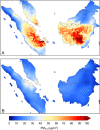The health impacts of Indonesian peatland fires
- PMID: 35790967
- PMCID: PMC9256533
- DOI: 10.1186/s12940-022-00872-w
The health impacts of Indonesian peatland fires
Abstract
Background: Indonesian peatlands have been drained for agricultural development for several decades. This development has made a major contribution to economic development. At the same time, peatland drainage is causing significant air pollution resulting from peatland fires. Peatland fires occur every year, even though their extent is much larger in dry (El Niño) years. We examine the health effects of long-term exposure to fine particles (PM2.5) from all types of peatland fires (including the burning of above and below ground biomass) in Sumatra and Kalimantan, where most peatland fires in Indonesia take place.
Methods: We derive PM2.5 concentrations from satellite imagery calibrated and validated with Indonesian Government data on air pollution, and link increases in these concentrations to peatland fires, as observed in satellite imagery. Subsequently, we apply available epidemiological studies to relate PM2.5 exposure to a range of health outcomes. The model utilizes the age distribution and disease prevalence of the impacted population.
Results: We find that PM2.5 air pollution from peatland fires, causes, on average, around 33,100 adults and 2900 infants to die prematurely each year from air pollution. In addition, peatland fires cause on average around 4390 additional hospitalizations related to respiratory diseases, 635,000 severe cases of asthma in children, and 8.9 million lost workdays. The majority of these impacts occur in Sumatra because of its much higher population density compared to Kalimantan. A main source of uncertainty is in the Concentration Response Functions (CRFs) that we use, with different CRFs leading to annual premature adult mortality ranging from 19,900 to 64,800 deaths. Currently, the population of both regions is relatively young. With aging of the population over time, vulnerabilities to air pollution and health effects from peatland fires will increase.
Conclusions: Peatland fire health impacts provide a further argument to combat fires in peatlands, and gradually transition to peatland management models that do not require drainage and are therefore not prone to fire risks.
Keywords: Health effects; Indonesia; Peatland fires.
© 2022. The Author(s).
Conflict of interest statement
The authors declare that they have no competing interests.
Figures




References
-
- Vetrita Y, Cochrane MA. Fire frequency and related land-use and land-cover changes in Indonesia’s peatlands. Remote Sens. 2020;12(1):5. doi: 10.3390/rs12010005. - DOI
-
- Stockwell CE, Jayarathne T, Cochrane MA, Ryan KC, Putra EI, Saharjo BH, Nurhayati AD, Albar I, Blake DR, Simpson IJ, Stone EA, Yokelson RJ. Field measurements of trace gases and aerosols emitted by peatland fires in Central Kalimantan, Indonesia during the 2015 El Niño. Atmos Chem Phys. 2016;16(18):11711–11732. doi: 10.5194/acp-16-11711-2016. - DOI
-
- World Bank and Government of Indonesia . Pilot ecosystem account for Indonesian peatlands. Washington, D.C.: Published by the World Bank, WAVES Program; 2018.
-
- Cahyono SA, Warsito SP, Andayani W, Darwanto DH. Faktor-Faktor Yang Mempengaruhi Kebakaran Hutan Di Indonesia Dan Implikasi Kebijakannya. Jurnal Sylva Lestari. 2015;3:103–112. doi: 10.23960/jsl13103-112. - DOI
-
- Rasyid F. Permasalahan dan Dampak Kebakaran Hutan. Widyaiswara Network Journal. 2014;1:47–59.
Publication types
MeSH terms
Substances
LinkOut - more resources
Full Text Sources
Medical

